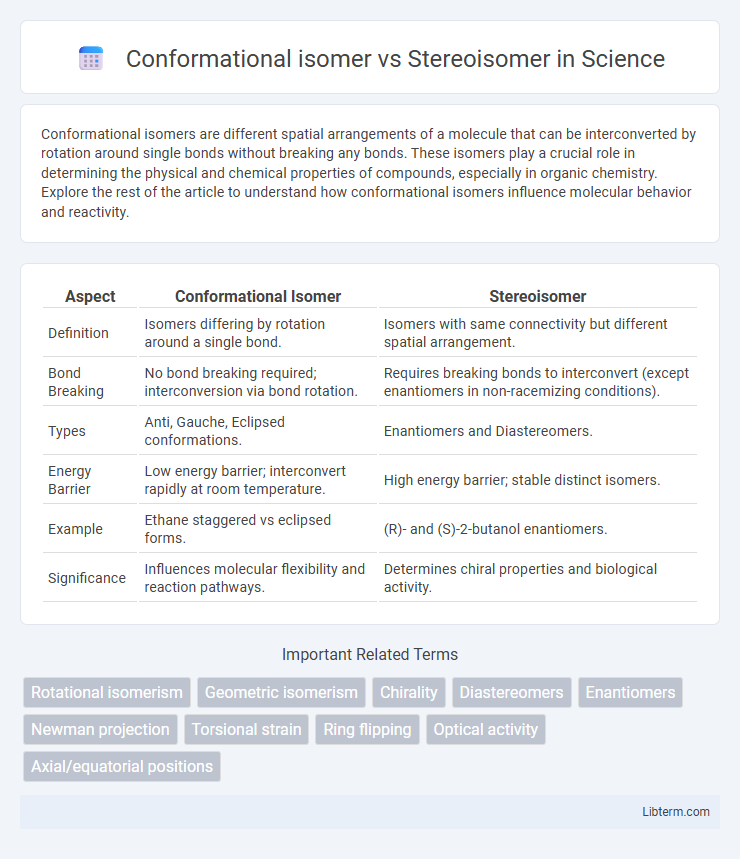Conformational isomers are different spatial arrangements of a molecule that can be interconverted by rotation around single bonds without breaking any bonds. These isomers play a crucial role in determining the physical and chemical properties of compounds, especially in organic chemistry. Explore the rest of the article to understand how conformational isomers influence molecular behavior and reactivity.
Table of Comparison
| Aspect | Conformational Isomer | Stereoisomer |
|---|---|---|
| Definition | Isomers differing by rotation around a single bond. | Isomers with same connectivity but different spatial arrangement. |
| Bond Breaking | No bond breaking required; interconversion via bond rotation. | Requires breaking bonds to interconvert (except enantiomers in non-racemizing conditions). |
| Types | Anti, Gauche, Eclipsed conformations. | Enantiomers and Diastereomers. |
| Energy Barrier | Low energy barrier; interconvert rapidly at room temperature. | High energy barrier; stable distinct isomers. |
| Example | Ethane staggered vs eclipsed forms. | (R)- and (S)-2-butanol enantiomers. |
| Significance | Influences molecular flexibility and reaction pathways. | Determines chiral properties and biological activity. |
Introduction to Molecular Isomerism
Molecular isomerism encompasses different compounds sharing the same molecular formula but varying in spatial or structural arrangement, with conformational isomers arising from rotation around single bonds, and stereoisomers involving fixed spatial differences such as chirality or geometric configurations. Conformational isomers, including staggered and eclipsed forms, rapidly interconvert and influence molecular flexibility and reactivity. Stereoisomers, subdivided into enantiomers and diastereomers, have distinct three-dimensional arrangements affecting physical and chemical properties crucial for applications in pharmaceuticals and materials science.
Defining Stereoisomers: An Overview
Stereoisomers are molecules with the same molecular formula and connectivity but differ in the spatial arrangement of atoms. This category includes conformational isomers, which interconvert through rotations around single bonds, and configurational isomers, which require bond breaking to interconvert. Understanding stereoisomers is crucial for studying molecular geometry, reactivity, and biological activity in organic chemistry.
What Are Conformational Isomers?
Conformational isomers are a type of stereoisomer that differ by the rotation around a single sigma bond, resulting in different spatial arrangements without breaking any bonds. These isomers interconvert rapidly at room temperature, reflecting various shapes such as staggered or eclipsed conformations in molecules like ethane. Understanding conformational isomerism is crucial in fields like organic chemistry and drug design, as molecular shape strongly influences chemical reactivity and biological activity.
Types of Stereoisomers: Geometric vs. Optical
Conformational isomers differ by rotation around single bonds and interconvert rapidly without breaking bonds, while stereoisomers maintain a fixed spatial arrangement due to restricted bond rotation or chiral centers. Types of stereoisomers include geometric isomers, which arise from restricted rotation around double bonds or ring structures and differ in cis/trans or E/Z arrangements, and optical isomers, which contain chiral centers and exist as non-superimposable mirror images called enantiomers. Geometric isomers impact physical properties like boiling points, whereas optical isomers affect optical activity and interaction with polarized light.
Key Differences: Conformational vs. Stereoisomers
Conformational isomers, also known as conformers, differ by rotation around single bonds and can interconvert rapidly at room temperature without breaking bonds. Stereoisomers have the same molecular formula and connectivity but differ in spatial arrangement of atoms, including configurations like enantiomers and diastereomers, which require bond breaking to interconvert. The key difference lies in conformers' dynamic, energy-dependent rotations versus stereoisomers' fixed three-dimensional arrangements with distinct chemical and physical properties.
Molecular Structures and Spatial Arrangements
Conformational isomers differ by rotation around single bonds, resulting in distinct spatial arrangements without breaking covalent bonds, reflecting dynamic molecular flexibility. Stereoisomers possess the same connectivity but differ in the fixed spatial orientation of atoms or groups, such as in enantiomers or diastereomers, creating non-superimposable three-dimensional structures. Understanding these molecular structures and spatial configurations is essential for predicting chemical reactivity and biological interactions.
Energy Barriers: Conformational Changes Explained
Conformational isomers differ by rotations around single bonds and typically experience low energy barriers, usually ranging from 2 to 20 kcal/mol, allowing rapid interconversion at room temperature. Stereoisomers, such as enantiomers and diastereomers, involve changes in spatial arrangement without bond rotation and possess higher energy barriers, often exceeding 50 kcal/mol, resulting in more stable, distinct configurations. Understanding these energy barriers is crucial for predicting molecular behavior, reactivity, and stability in chemical and biological systems.
Common Examples in Organic Molecules
Conformational isomers in organic molecules commonly include staggered and eclipsed conformations of ethane and chair versus boat forms of cyclohexane, illustrating rotations about single bonds without breaking covalent bonds. Stereoisomers encompass enantiomers and diastereomers, frequently observed in compounds like tartaric acid and 2-butene, where spatial arrangement around chiral centers or double bonds differ. These examples highlight the fundamental distinction between energy fluctuations in conformers and fixed spatial configurations in stereoisomers.
Biological and Chemical Significance
Conformational isomers play a crucial role in enzyme-substrate interactions by allowing biomolecules to adopt specific shapes necessary for biological activity, influencing protein folding and function. Stereoisomers, including enantiomers and diastereomers, exhibit distinct biochemical properties and pharmacological effects due to their fixed spatial arrangements, which impact drug efficacy and metabolic pathways. Understanding the difference between conformational and stereoisomers aids in drug design and synthesis, optimizing interactions with biological targets for therapeutic benefits.
Conclusion: Comparing Isomer Importance in Chemistry
Conformational isomers represent different spatial orientations of the same molecule that interconvert by rotation around single bonds, crucial for understanding molecular flexibility and reactivity. Stereoisomers, including enantiomers and diastereomers, have fixed spatial arrangements impacting biological activity and chemical properties significantly. Both isomer types are fundamental in chemistry, with conformational isomers influencing dynamic molecular behavior and stereoisomers affecting molecular recognition and function.
Conformational isomer Infographic

 libterm.com
libterm.com